

| Home Modifications Among Households With Physical Activity Limitations People who have physical activity limitations can use various means within their homes to compensate for a reduced ability to perform certain functions. First, they may use a home modification or fixture such as a grab bar. Second, they may take advantage of the help of another person, such as a family member, relative, or formal caregiver. Third, they may use equipment such as a wheelchair, walker, or motorized cart within the home. The national 1995 American Housing Survey (AHS) had a special supplement that asked whether members of households had permanent physical activity limitations and, if so, whether home modifications were present. The supplement also asked about the types of activity limitations that household members experienced. Households that reported at least one member who had a physical activity limitation were asked about the presence of certain home modifications. Last, regardless of whether or not they had home modifications present, these households were asked if they needed home modifications. HUD and the Bureau of the Census have released these data. The tables based on these data will soon be released.1 Based on the survey, it is estimated2 that in 1995, almost 8.9 million housing units in the United States had at least one occupant who had a physical activity limitation—approximately 9.1 percent of the 97.7 million occupied housing units that year. As many as 3.4 million (38.4 percent) of homes with at least one occupant with activity limitations had some type of home modification (such as grab bars and ramps) present. In 3.3 million (36.9 percent) of the homes, an occupant suffering from activity limitations received help from another person. Canes, walkers, or crutches were used in 3.4 million (37.9 percent) of the homes; wheelchairs, 1.4 million (15.3 percent); motorized or electric carts, 161,000 (1.8 percent); and other devices, 462,000 (5.2 percent). Nearly 3.6 million (40.2 percent) households in which at least one member had an activity limitation used no personal help or equipment. Approximately 5.1 million (57.4 percent) of the households in which a member had an activity limitation had no home modifications present. This article reports national estimates of the presence of, and the need for, modifications in the homes of households with activity limitations. Activity Limitations Among Household Members As mentioned earlier, approximately 9.1 percent of U.S. households reported at least one member who had an activity limitation. Table 1 indicates the prevalence of different types of activity limitations across all households, including both owners and renters. Difficulty performing personal activities and getting around in the home were experienced in approximately half of the almost 8.9 million households that had at least one member with an activity limitation. Among all households in the United States, 4.7 percent had at least one member who had difficulty performing personal activities, while 4.4 percent had difficulty getting around in the home. More than 3.4 million households (3.6 percent) reported that a household member had difficulty going up and down steps. Members of more than 3.2 million households (3.3 percent) had difficulty doing housework and laundry, and members of almost 2.9 million households (3.0 percent) had difficulty bathing. Almost 2.7 million households (2.8 percent) had at least one member who had difficulty seeing. Difficulty entering and exiting the home was reported by 2.6 million households (2.7 percent). Only 508,000 households (0.5 percent) reported members who have difficulty feeding themselves.
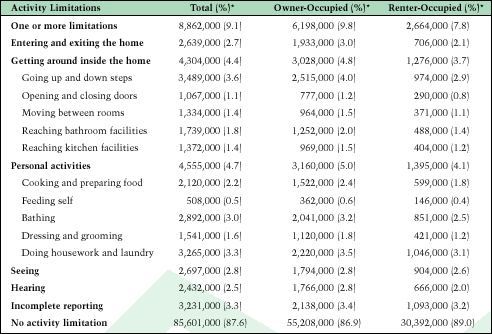
The Presence of Home Modifications The 1995 AHS supplement asked those households in which at least one member had a permanent physical activity limitation about the presence of home modifications. Table 2 shows data on the presence of specific home modifications in households with activity limitations and, among these households, for owners and renters. In 1995, as many as 3.4 million households (38.4 percent) in the United States containing at least one occupant with an activity limitation had home modifications present. Handrails and grab bars were the most common home modifications and were present in more than 2 million households (22.6 percent) reporting activity limitations. Widened doors or hallways were present in 756,000 (8.5 percent) of the households reporting activity limitations. Ramps were present in 736,000 homes, and easy-access bathrooms were present in 713,000 homes; each modification accounted for approximately 8 percent of the homes of households with activity limitations.
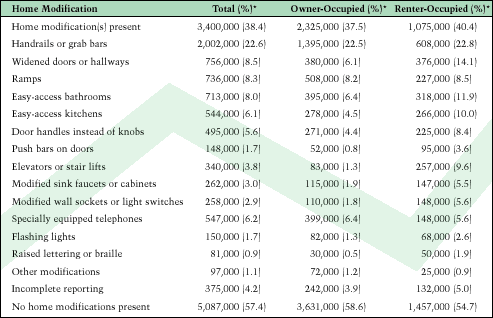
Among households with activity limitations, home modifications were slightly more prevalent among renters (40.4 percent) than among owners (37.5 percent). However, as shown in table 2, some modifications were present among renter households at a much higher rate than among owner households, including widened doors or hallways, easy-access kitchens, easy-access bathrooms, elevators or stair lifts, and door handles instead of knobs. The greater incidence of home modifications among renters is at least partly due to a greater proportion of rental housing, as opposed to owner-occupied housing, being targeted toward people with activity limitations; home modifications in these special housing units are included in the design and construction stage. In addition, the Americans With Disabilities Act requires public accommodations to have certain design features to ensure access for persons with disabilities. The Unmet Need for Home Modifications The 1995 AHS supplement also asked respondents if they needed specific home modifications to address permanent physical activity limitations of household members. Households that did not have, but expressed a need for, a specific modification are characterized as having an unmet need for that modification. Table 3 presents data on unmet need for specific home modifications in households with members who have activity limitations and, among those households, for owners and renters. The greatest unmet home modification need among households with activity limitations was handrails or grab bars; as many as 788,000 (8.9 percent) of the households with activity limitations reported this need. There also were significant unmet needs for ramps and easy-access bathrooms; as many as 612,000 households (6.9 percent) had an unmet need for ramps, and 566,000 households (6.4 percent) had an unmet need for easy-access bathrooms.
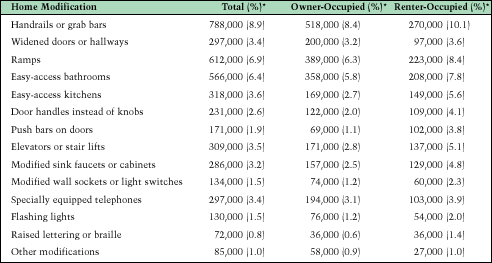
Elderly Households It is not surprising that activity limitations were far more prevalent among the 20.8 million households headed by an elderly person—that is, someone who is 65 years or older. More than one-fifth of elderly households (22.8 percent) had at least one member with physical activity limitations. This is in contrast with only 5.3 percent of nonelderly households and only 9.1 percent of all households. In light of the greater prevalence of activity limitations among this significant and growing demographic group, the data for households headed by an elderly person are described separately in tables 4, 5, and 6. As seen in table 4, among the specific activity limitations on which AHS collected data, difficulty with going up and down steps, doing housework and laundry, and bathing were the most common limitations, with each occurring in more than 8 percent of elderly households. Activity limitations occurred at a higher rate among the 4.5 million elderly renters than among the 16.3 million elderly owners in every category but one.
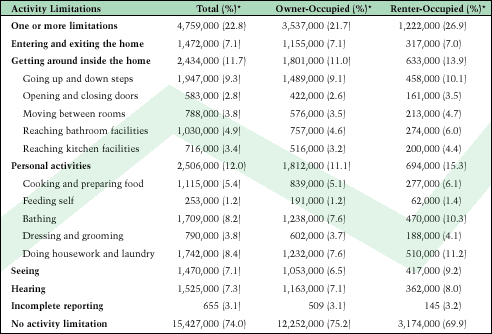
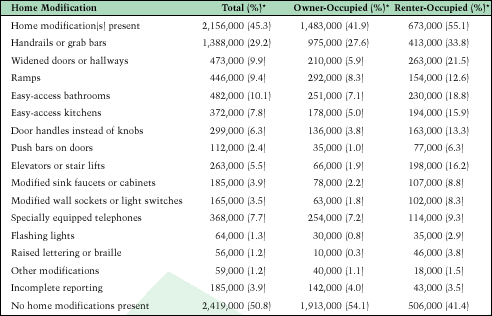
Table 6 presents data on unmet needs for specific home modifications among elderly households with activity limitations. Separate figures for elderly owners and renters are not available in the published AHS supplement tables. The rate of unmet needs for nearly all of the specific home modifications for which data were collected is lower among elderly households compared with all households with activity limitations. These differences are, however, quite small and never exceed a single percentage point. For example, 3.2 percent of all households with activity limitations had an unmet need for modified sink faucets or cabinets and 2.2 percent of elderly households with activity limitations had the same need. It is worth noting that although elderly households with activity limitations have, on average, lower incomes than all households with activity limitations, the rate of unmet needs among them also is lower. The fact that, despite lower incomes, elderly households with activity limitations did not have a higher rate of unmet needs attests to the success of the various programs that address the housing needs of the elderly.
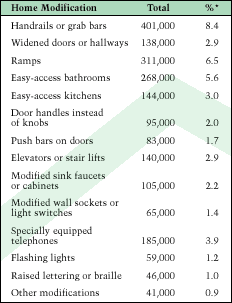
Accessing the 1995 AHS Supplement Data HUD and the Census Bureau have given high priority to making AHS accessible. The 1995 AHS supplement is available in tabular and microdata formats. The tables will be available in print form and PDF format by the end of May 2001. The microdata files (in ASCII) are available on CD-ROM or can be downloaded from the Internet. Copies of the printed version of the supplement tables will be available from HUD USER at the end of May 2001 (1-800-245-2691). Both the Census Bureau and HUD maintain Web sites, and HUD operates an AHS listserv4 for the AHS user community. The HUD Web site for AHS is www.huduser.gov/datasets/ahs.html. At this site one can find 1995 microdata files for downloading in ASCII format, summary statistics of the 1995 survey, the codebook for the survey, and links to the Census Bureau's Web site. The AHS Census Bureau's Web site is www.census.gov/hhes/www/ahs.html. This site provides PDF versions of the AHS reports and access to the 1995 microdata files for extracts and analyses by means of the Census Bureau's Data Extraction System. The site also provides information on ordering reports and documents from Customer Services, Census Bureau, Washington, DC 20233-8500, telephone number: 301-457-4100. Notes 1. U.S. Department of Housing and Urban Development and U.S. Census Bureau, American Housing Survey for the United States, Supplement: 1995, Current Housing Reports, Series H151/95, U.S. Government Printing Office, Washington, D.C., forthcoming. 2. All data presented in this article are based on a representative probability sample and are subject to sampling error. Nonsampling error is also present. An appendix to the AHS report contains more details on survey error. 3. This figure is consistent with data from the Survey of Asset and Health Dynamics Among the Oldest Old of 1993–94, based on which it was estimated in Kutty (1999, "Demand for Home Modifications: A Household Production Function Approach." Applied Economics. 31, pp. 1273-1281) that 40 percent of elderly households had some home modification. Fewer types of home modification were included in that data set, and the survey was not restricted to households with activity limitations; however, the data set was for households that contained a member who was 70 years or older.
4. To subscribe, send a message to: helpdesk@huduser.gov. In the body of the e-mail, type:
"subscribe AHS [your first and last name]".
|